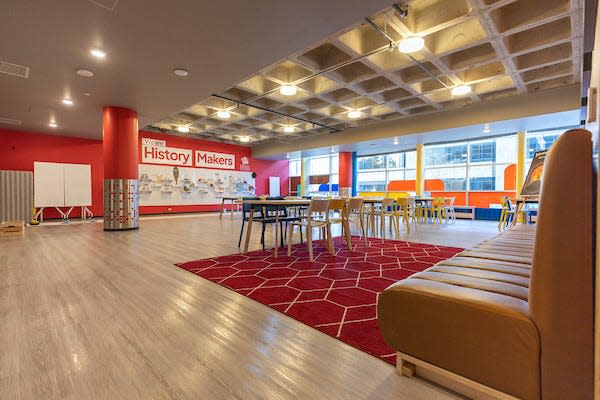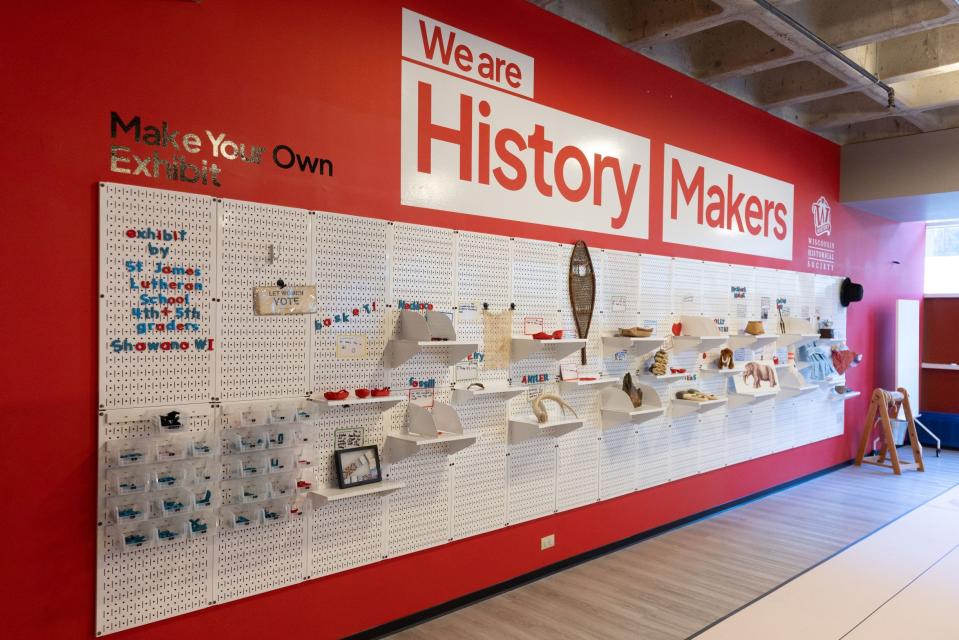New History Maker Space and statewide tour bring Wisconsin history to students and residents

Fourth grade is when the state's schoolchildren typically learn Wisconsin history. To supplement those lessons, they take a field trip to Madison to visit the capitol, meet their representatives, maybe take a trip to the zoo and visit the state history museum.
Until recently.
The history museum closed earlier this year as preparations began in earnest to build a new Wisconsin History Center, which will be finished in late 2026. While the promise of a new museum is exciting, for three years, fourth graders will be taking their Madison field trips without a history museum.
That's where the new History Maker Space comes in. The area is on the main level of the US Bank Plaza on Madison's Capitol Square and houses a retail space and pop-up history exhibits that are open to the public, as well as a special event space and an interactive education space for field trips.
"This is a whole new thing for us," said Nick Hoffman, the Wisconsin Historical Society's administrator of museums and historic sites. "In the old museum, we would do facilitated tours of exhibit spaces. Since we don't have that anymore, we're being challenged to think about how to do history programming in a new and different way."
That new programming focuses on showing students how "they can see themselves as making history every single day."
A new type of field trip
Abby Pfisterer is the director of PK-12 education for the Wisconsin Historical Society. She said students who come to the History Maker Space will take part in a hour-long field trip that has three main parts.
First, students are presented with a timeline of Wisconsin history. Pfisterer said they deconstruct the state seal to explore key moments in state history. Then they "complicate the narrative" by going back in time before Wisconsin became a state to learn the stories of some of the people who lived here back then. Finally, students are asked about their own experiences in Wisconsin and how those stories would fit into the timeline.
After the timeline activity, students take part in a history exploration activity. Groups of students are each given an object, an image and a quote.
"They use these primary sources to figure out the story," Pfisterer said. "They practice historical investigation and historical thinking as they learn about their sources. Then the groups get to teach each other what they learned."
The objects the students use are called teaching objects, which are reproductions of artifacts that would be displayed in a museum — things like butter churns, mammoth tusks and fur trade tools. Pfisterer said the primary sources revolve around key points of Wisconsin history, such as lead mining, wild rice harvesting, logging, immigration and the historic dugout canoes that were recently discovered in Lake Mendota.

In the final portion of the program, students are encouraged to utilize what they learned about Wisconsin's timeline and historical thinking to create their own exhibit on a huge back wall that is set up so students can move objects and shelves around, create labels, and tell the stories they want to tell about Wisconsin history.
"We have historic images they can pick from, we have teaching objects, we even have modeling clay," Pfisterer said. "Everyone picks one thing, creates a label and explains the story they want to share.
"It's been cool to see them put together these vibrant and dynamic exhibits that they take pride in, and they get their picture taken under this big banner that says, 'We are history makers.'"
Pfisterer said this type of programming — focused on history as a continuing story that everyone takes part in as opposed to something that happened so long ago as to feel irrelevant — is setting the stage for the types of exhibits and programming that will be in the new History Center.
"We're really using this space as a laboratory for the next three years as we figure out what works best in determining the educational programming in our new history center," Pfisterer said.
Taking Wisconsin history on the road
The History Maker Space also serves another purpose.
"We kind of see the space as our base camp as we also continue telling the story to the public of Wisconsin history in a three-year tour throughout every county of the state," said Angela Titus, chief program officer for the Wisconsin Historical Society.

The Wisconsin History Makers Tour will travel throughout Wisconsin over the next three years, bringing pop-up history exhibits, speakers, author talks and programming to local partners including libraries, local history and culture institutions, and even highway rest stops.
Titus said the programming and exhibits are being built around the theme "How we do things in Wisconsin." Topics include Wisconsin sports figures and fan culture, agriculture, maritime history, archaeology, and an exhibit built around the different ways that Wisconsinites gather and celebrate.
"We also have programming around activism and all of the work that has come out of our state in terms of people fighting for what they believe in," Titus said. "Subjects like the migrant farmworkers movement, civil rights, the labor movement and women's suffrage. There are so many great examples that show how individuals can make history every day."
The tour, which began in September, will bring its exhibits and programming to all 72 counties in the state through February 2027. It's scheduled to be in the southeast region — with programs in cities including Milwaukee, Kenosha, Port Washington, Racine and Waukesha — from April through October 2024.
But Titus anticipates that the History Makers Tour will maintain a presence in Milwaukee throughout the entire three years, starting with programming through the Milwaukee County Historical Society in January.
"We'll be going into Milwaukee early and will probably be there the whole three years," Titus said. "Milwaukee is a big market, we have a regional office there, we've published a lot of books about Milwaukee history, and we have a great partner in the county historical society."
Specific programs and exhibits for the Milwaukee area haven't been announced yet, but the Wisconsin Historical Society website will be updated as programming details are finalized.
This article originally appeared on Milwaukee Journal Sentinel: Wisconsin Historical Society debuts Madison field trip space and tour

